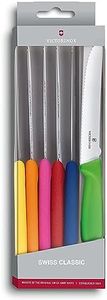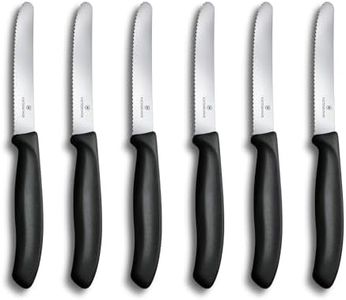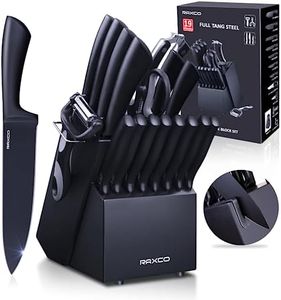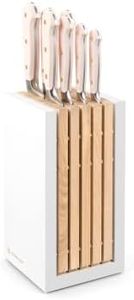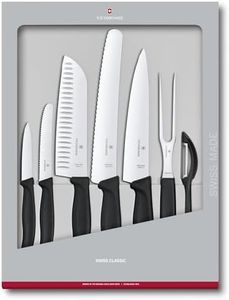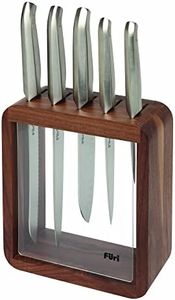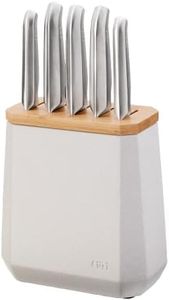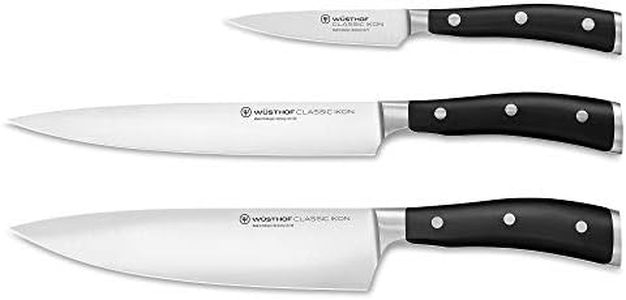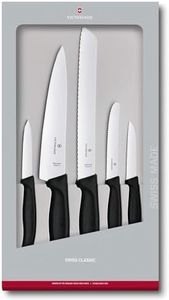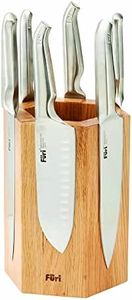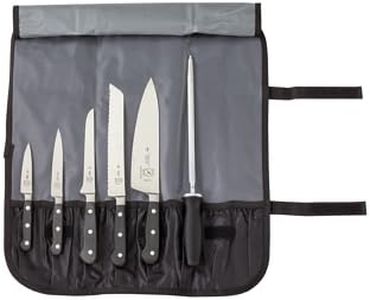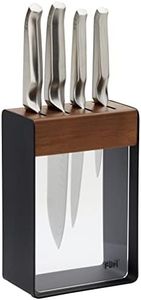We Use CookiesWe use cookies to enhance the security, performance,
functionality and for analytical and promotional activities. By continuing to browse this site you
are agreeing to our privacy policy
10 Best Budget Knife Set
From leading brands and best sellers available on the web.Buying Guide for the Best Budget Knife Set
Choosing the right knife set can make food preparation safer, faster, and more enjoyable. Before you buy, think about the types of foods you regularly prepare and the number of knives you actually need — sometimes, fewer well-chosen knives are better than a large set with rarely used pieces. Always look for sets that offer essential knives for your usual cooking tasks, and consider the overall feel and balance of each knife to make sure they're comfortable for you. Durability, ease of maintenance, and safety are also key factors to consider.Blade MaterialBlade material determines how well the knives stay sharp, resist rust, and maintain their edge. The most common materials are stainless steel, which is rust-resistant and easy to maintain, and carbon steel, which holds a sharp edge longer but requires more care. Some sets also use composites or ceramic. For most everyday cooks, stainless steel is a safe and practical choice since it offers a good balance of sharpness and durability with minimal upkeep. If you want a longer-lasting edge and don't mind a bit more maintenance, carbon steel is an option, but it's best for those willing to oil their knives and avoid dishwashers.
Number and Types of Knives in the SetKnife sets come in different sizes, ranging from a simple trio of essentials (like a chef’s knife, paring knife, and bread knife) to extensive collections that include specialty knives. More isn't always better—focus on key knives you'll use most. A basic starter set should cover a chef's knife for general chopping, a paring knife for detailed work, and a bread knife for slicing breads and soft fruits. If you often carve meats or prep vegetables, consider sets with a carving or utility knife. Avoid being swayed by sets with many small, rarely-used pieces unless you really need them for your cooking style.
Handle Comfort and MaterialThe handle of a knife affects how comfortable and safe it feels in your hand, especially during long prep sessions. Handles are often made from plastic, wood, or composite materials. Plastic and composite handles are easy to clean and more resistant to water and bacteria, making them good for busy or multi-user kitchens. Wooden handles provide a classic look and a warmer feel but may require extra care to prevent cracking. Try holding a knife (if possible) to check if the grip feels secure and balanced for your hand size, especially if you have small or large hands. The right handle can reduce fatigue and improve control.
Weight and BalanceThe weight and balance of a knife influence how it feels when you use it. Heavier knives can make cutting through tough foods easier but may cause strain with repeated use. Lighter knives offer better speed and control for delicate tasks but may not be strong enough for hard foods. A well-balanced knife, where the center of mass is just at the handle-blade intersection, feels stable and predictable. Choose based on your strength and the types of food you prepare—a balanced, medium-weight knife usually works for most people and most tasks.
Ease of MaintenanceKnives should be easy to clean and maintain, keeping your kitchen safe and food tasting good. Dishwasher-safe knives save time but may become dull more quickly. Hand-washing preserves sharpness but requires more effort. Some knives need occasional sharpening or honing to stay effective, so a set with an included sharpener or honing rod is helpful. If you want minimal maintenance, stick with stainless steel and dishwasher-friendly handles, but know that even these will perform better if hand-washed and dried immediately after use. Your willingness to care for your knives should guide your choice here.
Storage SolutionA good knife set should come with a safe and convenient storage option, like a wooden block, drawer insert, or protective sheaths. Proper storage protects blades from damage and keeps your kitchen organized and safe. Blocks keep knives visible and accessible, while drawer inserts save counter space. Sheaths are useful if you plan to store knives loosely or travel with them. If you have a small kitchen, look for compact storage; if you want everything at your fingertips, a block is ideal.
